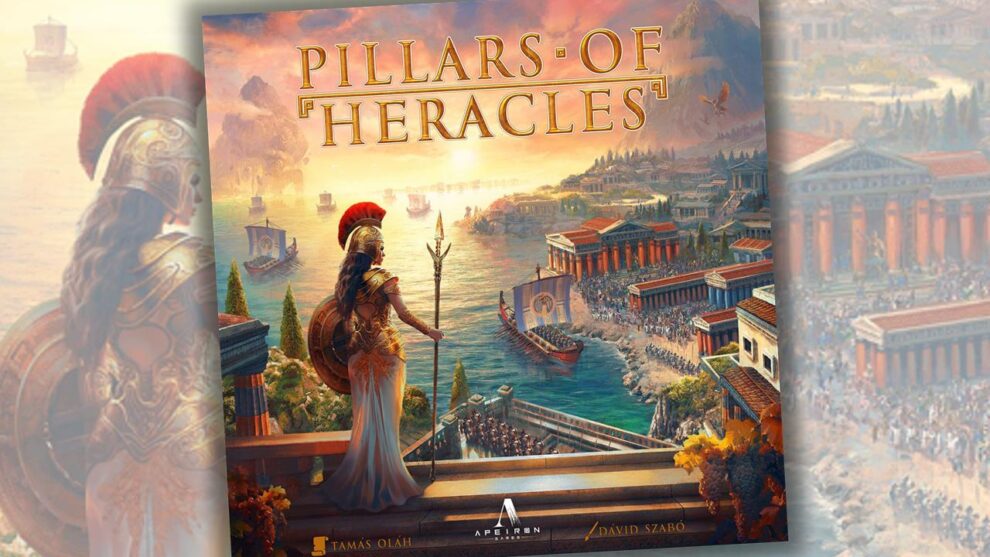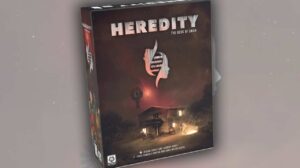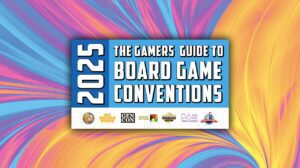Disclosure: Meeple Mountain received a free copy of this product in exchange for an honest, unbiased review. This review is not intended to be an endorsement.
Mythology from Mount Olympus
Some might say we’re in the golden age of board gaming. It seems nearly every week there’s a major release, and the revolving door of hype is always spinning. So many games are vying for attention, and only so many can make it through the door. When Pillars of Heracles hit the table, one player said, “Where did this come from? I’ve heard absolutely nothing about this.” And there lies the downside of board game hype: not every new game gets love.
Admittedly, I also hadn’t heard of this game until I walked by the Grand Gamers Guild booth at Origins and caught a couple of turns in action. Pillars comes to us from Hungarian designer Oláh Tamás, and after a successful Kickstarter, the game has made its way to retail. The pitch—an epic history of Ancient Greece mixed with Greek gods and asymmetric powers—had me running to the table. But with so many Ancient Greek-themed games already out there (Cyclades, Khora, Akropolis, and Santorini, to name a few), where does this one fall in the pack?
Pillars of Heracles is more of a “3.5X” game rather than a full 4X (eXplore, eXpand, eXploit, and eXterminate). Its standout feature is the boatload of game modes and modular mechanics that let you tune the game in all kinds of ways. Will it leave a lasting legacy or be forgotten in the history books? Join me on this quest to another time and age!
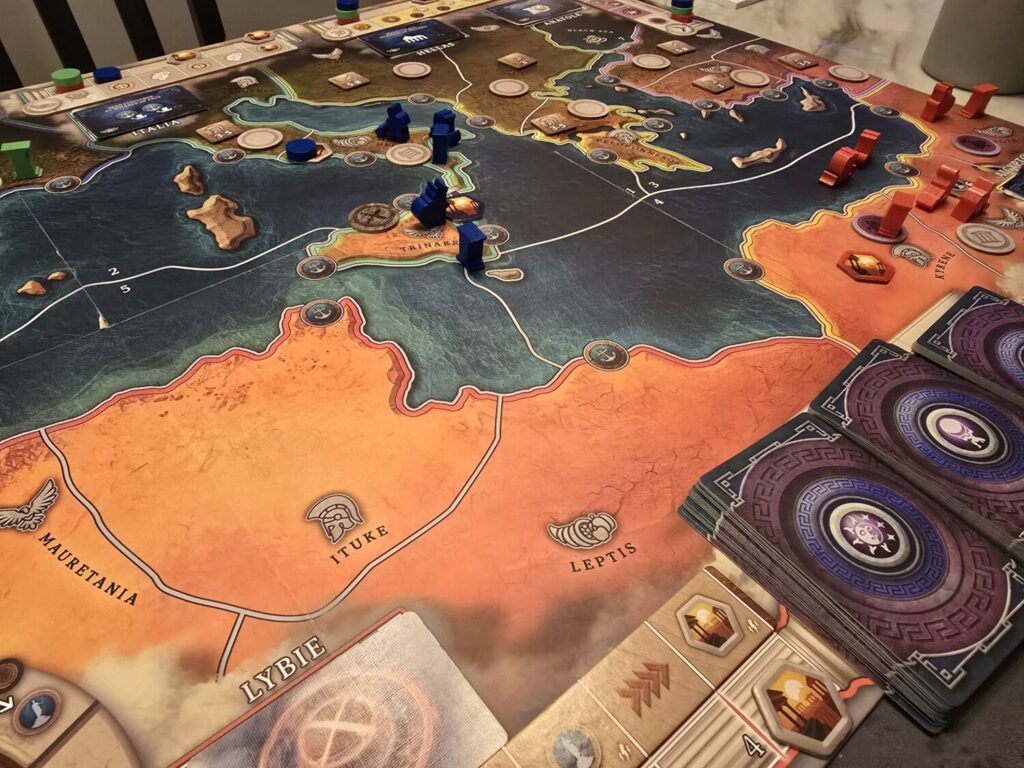
Rondel Republic
Focusing on the standard form of play, this competitive 1–4 player game has players drafting ancient city-states (like Sparta, among others) and starting on one of two map sides: the Mediterranean or Aegean Sea. Players begin with a multi-use deck of cards. The crux of the game is the action rondel—players play a card from their hand, with its power indicating how many steps to move.
Most actions involve unit movement. There are hoplites (army troops), boats (naval transport), and workers (used to build buildings or cities). The first action is “procure,” where players spend unspent cards from their hand as a resource to recruit character cards or monuments. Character cards are stronger and may contain secondary actions that trigger later when used for rondel movement. Monuments are more costly but worth points and often provide powerful action cards.
Other actions include deployment and building, which pull troops or buildings off your player board and into the world. Completing a row of either allows you to insert a tactic tile into the empty row, granting an ongoing effect. Another action is “settle,” the game’s primary expansion mechanic. Players encounter population tiles that must be met or exceeded in strength (via buildings and units). When successful, a player places a pillar tile on that space, unlocking its resource. Spending resources can then involve moving a pillar to a space’s resource token, essentially claiming a “free” resource. These can only be refreshed by passing (drawing cards) or using the ascend action. Conquest has its spoils—it inherently makes future actions cheaper.
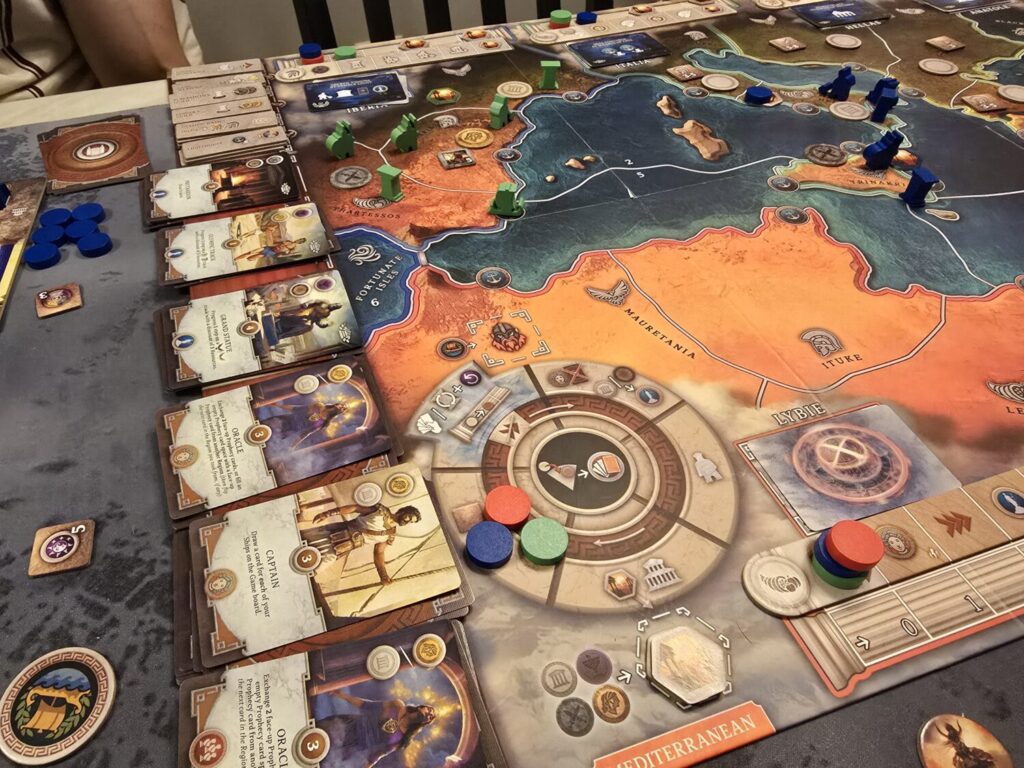
The final main action is “ascend”. Each region has a tech track tied to a specific resource type. Players can move up as many tracks as they can afford, gaining a slew of instant rewards. Free actions include claiming “prophecy” cards (end-game scoring goals), activating powerful god cards with disruptive effects, and deploying siege tiles.
At the start of each player’s turn, a status check occurs. If a siege token is in a region, a siege battle is triggered, comparing the strength of occupying units. Strength can be boosted by tactic cards. If victorious, the attacker replaces the other player’s pillar or city with their own marker, gaining control. If no siege is in play, a domination or consolidation check occurs. Domination lets a player move up a region’s track; consolidation generates extra resources for controlling three matching symbols.
Play continues until one of three endgame triggers: a sixth city is built, a set number of prophecy cards are fulfilled, or enough players reach the final tier of tech tracks.
Beyond the base game, there are tons of modular twists:
- Gods (more asymmetric powers)
- Barbarians (roaming neutral troops)
- Skirmish mode (more direct conflict)
- Atlantis (a neutral sea city)
- Short game and team mode options
Plus, the box includes two other modes of play:
- Siege of Destiny, a historic team mode recreating the Battle of Troy
- Dawn of Freedom, a robust solo mode vs. an AI opponent called The Tyrant
The game is highly modular, letting you mix and match elements to create the experience you want.
An Ancient Epic
There is a lot of game in this box, which makes for incredible value. It almost feels like three different games built on the same system—and no two games ever felt the same. Even just switching maps created vastly different experiences: the Mediterranean Sea is more open and strategic; the Aegean Sea feels cramped. For our group, the Mediterranean was the clear winner.
As I mentioned earlier, this feels like a “3.5X” game. It looks like a dudes-on-a-map area control game, but it’s more of a layered Euro with light conflict. Players only get three soldiers (four if unlocked), and they’re only enhanced by adjacent ships and tech track bonuses. Combat is small in scale—units aren’t even removed during sieges. I liked this restraint; it keeps the focus on engine-building. A siege token signals an attack is coming, giving the other player a full turn to prepare. Losing isn’t a disaster, and often you’re better off focusing your turn elsewhere. Sometimes it’s not worth spending a precious card to defend.
The real engine-building comes from character and monument cards. Like any deck-builder, cycling is key—and it’s cheap to buy cards. After just one or two procure actions, your deck feels stronger, and turns get juicy. Most games felt like 75% expansion/engine-building, then 25% conflict as space ran out.
The asymmetry is where this game shines—gods, city-state powers, decks, tactic tiles all make every game feel fresh. It’s most balanced at four players (thanks to full map seeding), but it plays best at three. Fewer players reduce downtime, give more room for expansion, and make conflict feel more strategic than disruptive. In a Euro game like this, early conflict can slow your engine-building, so it’s better left for the late-game when everyone is already powered up.
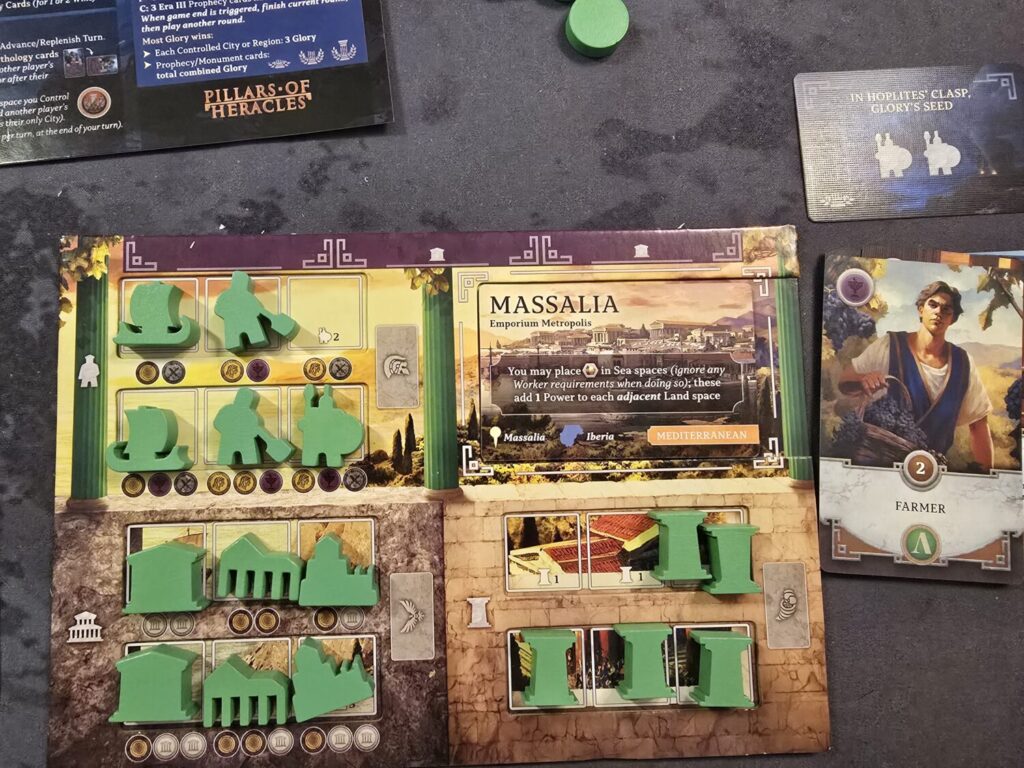
The rondel is one of my favorite mechanisms in any game, and it shines here. The actions are basic, but the rondel introduces a race to beat players to certain actions. Do you skip valuable spots or burn a powerful card for movement instead of a resource? That’s where the tension lies.
Hand management is tight. You only draw cards when passing (which also refreshes your resource pillars), and it always feels bad to skip a juicy board action just to draw. Thankfully, the game throws you a lifeline: if another player lands on the same rondel action as you, you draw a card. It’s an underrated joy, and often you’ll find yourself thanking your opponents for “helping out.”
But Even the Gods Had Flaws
Even the mightiest Olympians stumbled now and then, and Pillars of Heracles isn’t without its missteps. For all its grand ambition and modular glory, the game struggles under the weight of its complexity—particularly when everything is added at once. While each module sounds enticing on paper, layering multiple systems can create a tangled web of edge cases, vague interactions, and rule ambiguity.
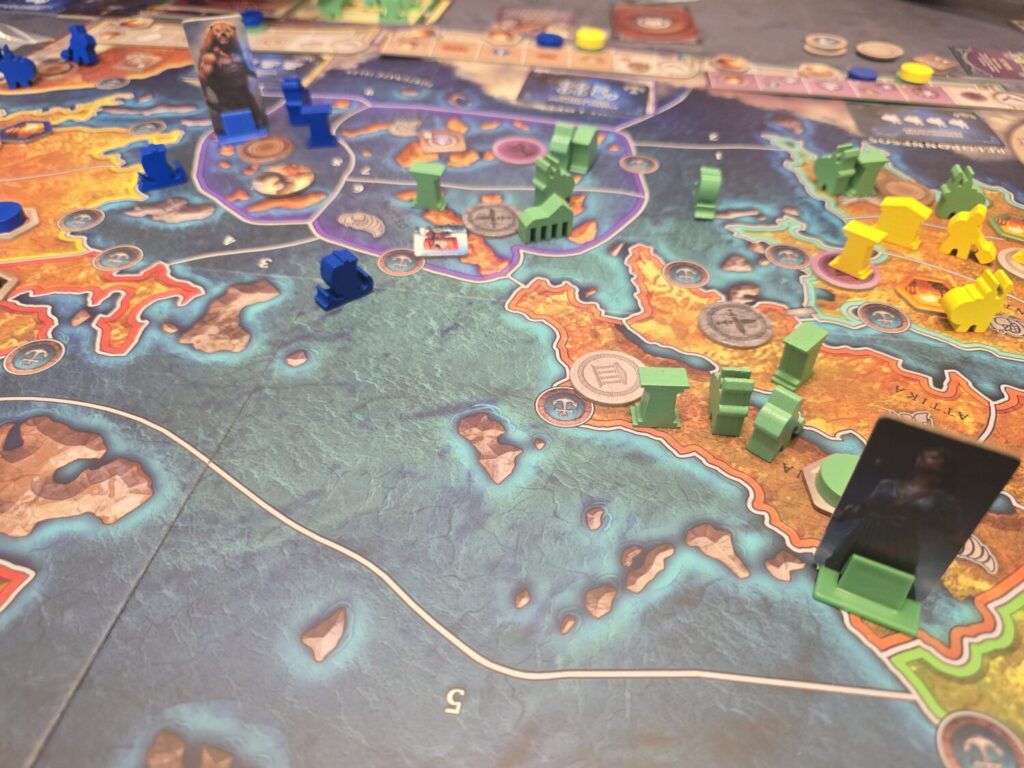
The biggest culprit is fiddliness. There’s a lot going on—between the base mechanics, god powers, city-state bonuses, tactic tiles, tech tracks, monuments, and prophecy goals—and not all of it meshes cleanly. While the base rules are actually well-written and organized (a feat for a game of this scale), it’s the modular add-ons where things get murky. Want to play with gods? Great. But what happens when a god’s ability conflicts with a region’s effect? Or when a prophecy goal isn’t clearly defined? The rulebook often leaves these edge cases hanging, and players are left to hash things out mid-game, stalling the momentum.
Our group encountered multiple situations that had us diving into the rulebook, checking errata, or scouring forums for clarification—only to end up house-ruling it just to move forward. It wasn’t a dealbreaker, but it was a mood-breaker.
The included player aids do their best to condense information, but they’re text-heavy and sometimes more overwhelming than helpful. They summarize the phases well, but don’t offer reminders about more niche rules. And while the gods are one of the coolest features thematically, they’re also one of the most under-explained mechanically. A single-line power description is sometimes all you get, and it’s not always enough. A dedicated god appendix or an included FAQ would go a long way to ease new players into the divine chaos.
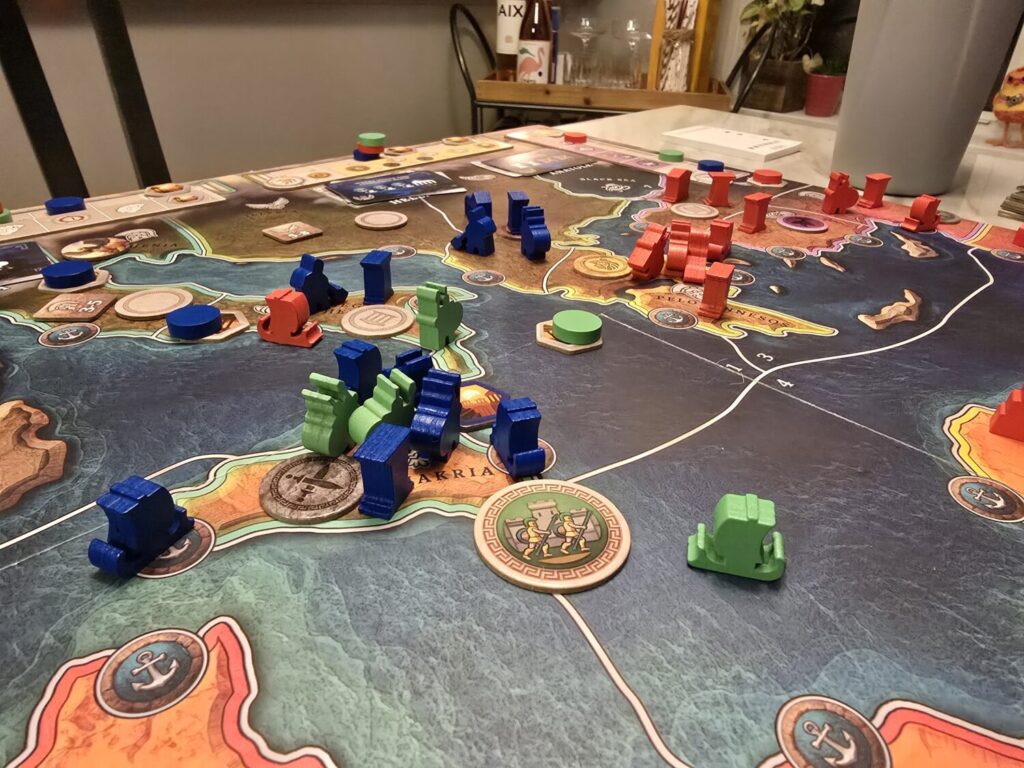
This isn’t to say the game is broken—far from it. But there’s a sense of “rough around the edges” that crops up in every session, especially for new players. It feels like a brilliant first draft that could have benefited from one more development pass to streamline and clarify some of the interactions. Ironically, the abundance of options is also what makes the game exciting. But when everything is turned on, it can overwhelm—not just in rules overhead, but in strategic focus. Some players felt like they were being pulled in too many directions without knowing what path was optimal, or even viable.
In short, Pillars of Heracles wants to be your everything game—and it nearly pulls it off. But the divine complexity comes at a cost: onboarding can be rough, and teaching the game to new players requires not just patience but frequent rulebook flips. With more polish and a few usability tweaks, this game could transform from “ambitious gem” to “modern classic.”
Final Thoughts
Pillars of Heracles is a really good game—but just shy of greatness. A few players said, “I like it, but something feels off.” Many of the systems are strong, but they don’t always flow smoothly. There’s not much guidance on strategy or how to win. Card play is a highlight, but sometimes feels “on rails,” especially early on before you unlock more flexibility. Scoring is simple (cities, regions, monuments, prophecy goals), but the paths to get there are wide open—and building in a direction can sometimes lead to a dead end.
Still, I had a great time creating wild synergies and testing different builds. I’m a big fan of asymmetry, and I think that’s both the game’s greatest strength and its Achilles’ heel—it makes for exciting replayability, but also lots of rules complexity. Like Odysseus, this game is about the journey. The card decks are thick with potential, and players quickly formed favorites they hoped to draft again. The core system isn’t revolutionary, but it’s a lot of fun to jockey for control and build your empire.

There’s already talk of an expansion (adding trade!) and a spin-off in the works. I’d love to see this turn into a series that explores other cultures and myths. I highly recommend giving this one a try—especially for fans of area control with light conflict, or Euro lovers looking for more player interaction. With stunning artwork and a historical guidebook included, this journey through Ancient Greece is absolutely worth taking.
Check out Pillars of Heracles at GenCon 2025 at Booth #2946!


